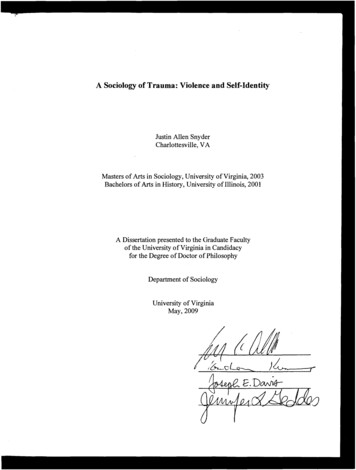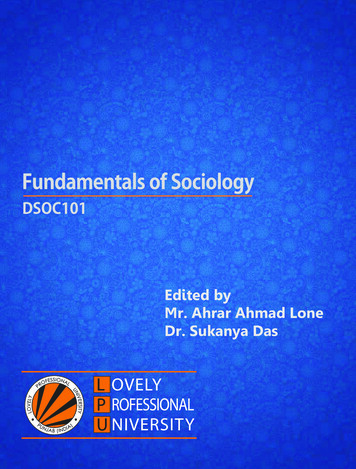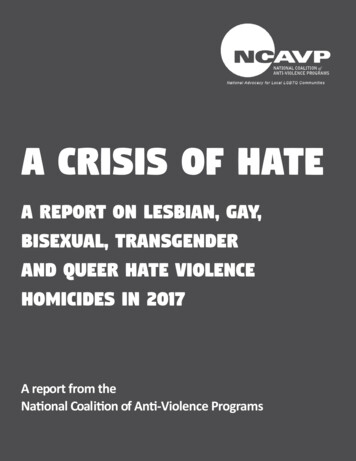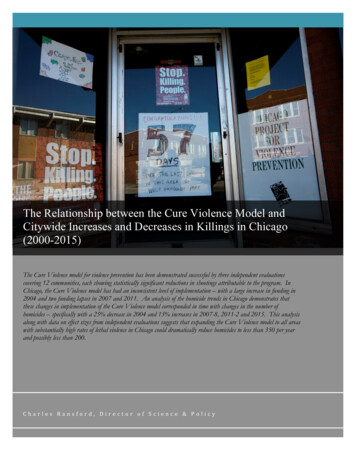
Transcription
A Sociology of Trauma: Violence and Self-IdentityJustin Allen SnyderCharlottesville, VAMasters of Arts in Sociology, University of Virginia, 2003Bachelors of Arts in History, University of Illinois, 2001A Dissertation presented to the Graduate Facultyof the University of Virginia in Candidacyfor the Degree of Doctor of PhilosophyDepartment of SociologyUniversity of VirginiaMay, 2009
Copyright byJustin Allen SnyderAll Rights ReservedMay 2009
Abstract: A Sociology of TraumaThis project relates the experience of violence to self-identity. It involves asystematic content analysis of memoirs published on rape, terrorism, genocide, and war.The content analysis provided a complex typology of traumatic stressors that is general tothe instances of violence considered. The typology is a style of formal sociologycomparable to what has been termed social pattern analysis (Zerubavel 2007). Theidentified stressors are as follows: the symbolic and cognitive expansion of violence, theloss of self-propriety during violent physical exchanges, the frustration of mundanechoices and routines, and the blurring of moral and cognitive boundaries.A theoretical description was fit to the empirical findings. The typologyillustrates that more happens in the process of violence than just direct physical harm. Iemploy the concepts of reflexivity and authenticity to describe the traumatic meaning ofthese events. Reflexivity and authenticity are two interrelated concepts used to captureaspects of contemporary Western self-identity. During violence, reflexivity andauthenticity appear impossible; the stressors undermine an individual's basic confidencein his or her self-concept. As a consequence, individuals experience a comprehensivemortification of the self. Symptoms of posttraumatic disorder (PTSD) result from thisexperience of severe humiliation.
A Sociology of TraumaAcknowledgementsAcknowledgementsJeff Olick, my dissertation chair, introduced me to my topic and encouraged me toapproach it in an ambitious way. I worry that his expectations exceed my talents, but hehas helped me write a dissertation of which I am proud. Throughout the developmentand writing processes, Jeff was earnest in his criticisms but always respected mydisagreements. I am sure I will regret not seeking his counsel more frequently.My readers from the sociology department are Joe Davis and Krishan Kumar.They both had an early impact on me as an academic. Both influenced the way that I dosociology and the kind of sociologist I am. I continue to be impressed with theirscholarship. Jennifer Geddes, my third reader, came late to this moment in myintellectual development, but I have gleaned her insight from afar, through publications,presentations, and questions at colloquiums.Milton Vickerman has been an important mentor for me in graduate school. Iremember him once telling me, "I want you to be successful." These small acts ofsupport can be extremely effective. I will never forget his well-timed words and willremember to offer them to my own students.I want to thank Brad Campbell and Jason Manning. Our friendship crosses one ofsociology's deepest paradigmatic divides, and our late-night arguments have served mebetter than any graduate course. Their social support has also kept me resilient to thefrustrations of graduate life. The same is true of my discussions with friend ElizabethSmiley.
A Sociology of TraumaAcknowledgementsiiThis dissertation is dedicated to my family. First are my parents. I hope myachievement repays some of my debt for their love. Finally is my wife, Amanda. Thisdissertation would not have been possible without her. She has been a benefactor,copyeditor, and therapist. Our intimacy has sustained me through years of stress and self discovery. My achievement is just as much hers as it is mine, and without Amanda mylife would be far diminished.
ContentsAcknowledgementsi-ii1. Introduction: A Living DeathVictimhood in the WestPosttraumatic CultureThe Psychology of TraumaSociology and TraumaTraumatic StressorsReflexivity and AuthenticityResearch DesignLimits of the ResearchA Map of What FollowsWriting about Trauma5710142. Past and Present Concepts of TraumaTrauma: A Brief Intellectual HistoryPosttraumatic Stress DisorderSubjectivity and Violence3. Authenticity and ReflexivityAuthentic IndividualityThe Reflexive SelfThe Labor of Trauma4. The Subjectivity of ViolenceReflexive Anxieties Toward ViolenceThe Sequestration and Mediation of ViolenceViolence UnboundThe Expansion of HarmWhen They Need Them Most5. The Entrancing Nature of Physical HarmThe Entrancing Nature of PerpetrationThe Victim RoleThe Traumatic Symptoms of EntrancementThe Meaningfulness of Violent 09111111122129135
6. Trauma and the MundaneTrauma and the BodyMalevolent EnvironmentsOrdinary Life: Work, Sex, and the FamilyThe Violence of Small Torments1371371521541627. Betrayal of Authenticity and ReflexivityBetrayal and Moral InjuryThe Perceptual Fog of ViolenceReaffirming Perception: Bearing Witness1641651751948. The Symptoms of Trauma"Other" Symptoms of TraumaA Mortified SelfThe Interpretation of SymptomsTrauma: An Ongoing Interpretative Process1981982072102229. Recovery and Resilience, Trauma and IdentityTrauma and Social SupportTherapists and Traumatic InterpretationsThe Sociology of Trauma and IdentityThe Authenticity of Anxiety226227234238244Bibliography250
A Sociology of TraumaA Living Death5Chapter 1Introduction: A Living DeathThis dissertation is about people who suffer trauma after violence. What istrauma? What happens in extreme violence to cause trauma? How do traumatizedpeople describe their experiences? How can sociology help us understand theirdescriptions? To answer these questions, I conducted a content analysis of memoirswritten on rape, terrorism, genocide, and war. The content analysis produced a typologyof traumatic stressors, which identifies stressor forms common to diverse violentexperiences. The stressors include the symbolic and cognitive expansion of violence, theloss of emotional propriety during violent physical exchanges, the frustration of mundanechoices and routines, and the blurring of moral and cognitive boundaries.The audience for this project is not just scholars who are interested in trauma. Itis also medical sociologists, sociologists of identity, sociologists of emotions, andcognitive sociologists. I situate the empirical findings by relating them to contemporaryself-identity. In particular, I use the notions of reflexivity and authenticity toconceptualize the meaning of the stressors and their relationship to traumatic symptoms.Authenticity refers to a sincere and voluntary identity defined by the individual.Authenticity is often expressed by one's choices regarding religion, morality,emotionality, appearance, work, recreation, sexuality, intimacies, and family life. Theagent of authenticity is reflexivity. Reflexivity is continuous self-observation and self-
A Sociology of TraumaA Living Death6management. Reflexivity and authenticity together serve as bases of contemporaryWestern individuality; they are sources of dignity.Reflexivity is a condition of doubt. The reflexive individual is responsible forcreating his or her own identity, and people are persistently anxious about this burden. Iconfirm what two prominent theorists of trauma have suggested in passing: "[O]ftentrauma does not present a radically new experience, but rather confirms some belief thatan individual has tried to evade" (van der Kolk and Mcfarlane 1996: 8). The typologizedstressors are meaningful signs for the individual that his or her burden is impossible. Inordinary life, people endure similarly embarrassing anomalies to reflexive authenticity,but not all at once, so individuals can regain comportment with relative ease. Duringviolence, these events accumulate, and dignity is difficult to restore. 1 Individualsexperience a comprehensive mortification of the self(Goffman 1961). One Holocaustsurvivor explains, "You lost the capability of proving to yourself, in a moment of doubt,that you are still the same human being you were when you came here. That being isgone, and only a miserably wretched creature remains in her place" (quoted Des Pres1975: 182). Though trauma is tied to common anxieties of reflexive individuality, thetraumatic mortification of self is an incomparable agony. Trauma is what Vietnamveteran Ron Kovic called "a living death."Individuals suffering posttraumatic stress disorder (PTSD) have been humiliatedto the point that their self-identity is symbolically annihilated. This accounts for1The "accumulation of anomalies" is a common mechanism for the ruptures of other kinds of socialentities, including, for example, scientific paradigms (Kuhn 1996), states (Goldstone 1991), and, Karl Marxthought, global political-economies (1978 [1848]).
A Sociology of TraumaA Living Death7symptoms of trauma: guilt, hypervigilance, social withdrawal, feelings of helplessnessand hopelessness, and death imagery. The notions of reflexivity and authenticity alsocapture the traumatic stress of symptoms, which continue the mortification of selfendured during extreme violence. The trauma victim's social network is crucial inbreaking this cycle of humiliation. In ordinary life, others help the individual maintain asense of dignified self-propriety; the same is true for an individual who has lived throughextreme violence.Victimhood in the WestMy project comes at a time when Westerners, indeed people across the globe,have devoted much of their attention to victimhood. 2 For example, under the banner ofmulticulturalism, Westerners are rewriting their national histories to give voice to therepressed (see Engelhardt 1995; Gitlin 1995; Glazer 1997; Hollinger 1995). This is oneagenda of identity politics, a new style of politics devoted to redressesing the uniqueneeds of oppressed categories (Bernstein 2005; Nash 2000: Ch. 4). Through identitypolitics, a number of groups have successfully secured apologies and financial redress forinjustices such as the Holocaust, sexual slavery, Japanese American internment duringWorld War II, the Tuskegee experiment, and settler policies toward indigenous groups inAustralia, Canada, and the United States (Barkan 2000; Barkan and Kam 2006; Marrus2006; Minow 1998; Torpey 2003, 2005; Weiner 2005). Restitution for past victimizationhas recently become so common and successful that some have deemed ours an "age ofapology" (Brooks 1999).2This trend gained deliberate speed at the latest after the Second World War (see Bartov 2000; Confino2005; Farmer 1999; Moeller 1996; Olick 2005).
A Sociology of TraumaA Living Death8Likewise, the legal system in the past 40 years has become increasingly attentiveto the rights of victims (Garland 2001), while the "victim defense" has become a standardstrategy for defendants, particularly female defendants, in homicide cases (Westervelt1998). In the economic sphere, entrepreneurs have capitalized on consumers' fascinationwith victims to sell books (O'Neill 2007; Lemann 1992) and perfume (King 2006), toboost TV ratings (Illouz 2003), and to attract tourists (Fitzpatrick 2007; Meskell 2006:168-170).Much of the discourse about victims is spoken in the language of therapy.Therapy models rhetoric and practice in politics (Nolan 1998), education (Hunter 2000),and corporate cultures (Illouz 2007: Ch. 1; Tucker 1999). Not surprisingly, individualsare increasingly seeking psychological services. Three of the seven most prescribeddrugs in the U.S. are antidepressants (Horwitz 2002: 4). According to the World HealthOrganization, depression was the fourth leading contributor to the global burden ofdisease in 2000 and will be second by 2020, behind only heart disease (WHO 2008).Considering that today the majority of therapy visits are for mild to moderate diagnosesof anxiety or depression, people are regularly seeking therapy for even common lifetroubles (Horwitz 2002). Sociologists and others often explain these facts not as a resultof increased stressors in contemporary life, but as the consequence of changing normsand classifications. These changes include the medicalization of life troubles, a newculture permissive of emotional expression, and the destigmatization of anxiety disordersand depression (Horwitz 2002; Moskowitz 2001; Reiff 1966; Shorter 1997: 322-7;Sommers and Sate! 2005).
A Sociology of TraumaA Living Death9In many psychiatric sessions discussion will tum to the patient's memories.Following the emergence of psychoanalysis, many therapeutic approaches assume thatmemories of past troubles cause current dysfunctions (Hacking 1995; see also Megill1998), but memory has also become an important framework for other kinds of misery.After a century of extremes (Hobsbawm 1994 ), for example, there has been a rush tomemorialize and commemorate collective atrocities and injustices of the past (see Fussell1975; Maier 1993; Olick and Coughlin 2003: 52-7; Olick and Robbins 1998; Winter2006).Robert Hughes believes these trends create a "whining, denunciatory atmosphere"(1993: 22). He is one of many scholars critical of this climate of victimhood, therapy,and memory (e.g. Finkelstein 2003: 47-55; Maier 1993; Rieff 1966; Sommers and Sate!2005; Summerfield 2001; Sykes 1992; Torpey 2005: 160-6). One concern among criticsis that people claim victimhood to evade personal responsibility. Writes a concernedauthor, "The ethos of victimization has an endless capacity . for exculpating one's selffrom blame, washing away responsibility in a torrent of explanation - racism, sexism,rotten parents, addiction, and illness" (Sykes 1992: 11; Holstein and Miller 1990: 108-9;Sommers and Sate! 2005: Ch. 3; also Young 2002). Another concern is that people nolonger value steely resolve. Christopher Lasch famously described our age as one of"diminishing expectations." According to Lasch, individuals "no longer dream ofovercoming difficulties but merely surviving them" (1979: 49), and in Ian Buruma's(1999) words, victimhood has become a "peculiar source of pride." The culture ofvictimhood for these critics is, in short, an orgy of self-pity.
A Sociology of TraumaA Living Death10Posttraumatic Culture"Trauma" is the emblem of contemporary victimhood. Psychiatrist DerekSummerfield writes,In Western societies the conflation of distress with "trauma" increasingly has anaturalistic feel; it has become part of everyday descriptions of life's vicissitudes.The profile of posttraumatic stress disorder has risen spectacularly, and it hasbecome the means by which people seek victim status- and its associated moralhigh ground - in pursuit of recognition and compensation (2001: 96).Paul Lerner and Michael Micale elaborate that "trauma has become a metaphor for thestruggles and challenges of late-twentieth-century life, a touchstone in a societyseemingly obsessed with suffering and victimization" (2001: 1). "Trauma" is a medicalconcept with powerful normative implications, first, because it is a category ofpsychological harm, which is a kind of harm receiving much attention. Second, thecommon formulation of trauma places the harm outside the individual and inside his orher environment. Trauma, conventionally defined, exculpates the victim and indicts theetiological circumstances.This was true of earlier scientific formulations of trauma- say, "railway spine"in the 1800s or "shell-shock" during World War I- but it is starkly true ofposttraumatic stress disorder, the now dominant diagnosis of severe trauma. AmericanVietnam veterans were the first to be officially diagnosed as suffering from the disorder.While after World War II "the symbol of the vet was GI Joe, the lovable, typical youngAmerican, the veteran who came home from Vietnam was perceived as something
A Sociology of TraumaA Living Death11sinister, disturbing, frightening" (quoted in Shephard 2001: 365). 3 Vietnam veteranswere viewed as prone to divorce, unemployment, alcohol and drug abuse, and violence.To explain the dysfunction of veterans, sympathetic experts determined that thevicissitudes of war had caused irreparable changes in the personality and psychology ofmany soldiers. They labeled these changes "post-Vietnam syndrome," a term whichclearly suggests the normative nature of the diagnosis. "Post-Vietnam syndrome" blamedveteran improprieties on the unnecessary war Americans had started. Robert Jay Lifton,a leading author of the diagnosis, explained, "Most of the harmful behavior that occurs inVietnam is due to the malignant environment we create there, an environment formurder" (quoted in Shephard 2001: 372). The lasting psychological effects of the war,according to Lifton, were ones that would occur to "all civilized men who have ever beensent to make murder in the name of virtue" (quoted in Herman 1992: 27).After committees were formed and conflicts resolved, Lifton and his colleaguessuccessfully medicalized the suffering of Vietnam veterans in the third edition of theDiagnostic and Statistical ofMental Disorders (DSM). In the process, "post-Vietnamsyndrome" became "posttraumatic stress disorder." The latter diagnosis can be widelyapplied to victims of any intensely threatening experience. PTSD locates disorder in theevents that befall an individual, not in his or her character. The intensity of potentialharm dominates the etiology of PTSD. This critical implication of the diagnosis has3Note that this image of GI Joe was a propagandistic fiction that estranged many soldiers (Fussell 1989).For a poignant but realistic account of the psychological effects of the Second World War, watch JohnHuston's Let There Be Light (1946), a government suppressed documentary of a military psychiatrichospital.
A Sociology of TraumaA Living Death12made it "almost totemic," as Summerfield puts it (2001: 95). After the DSM-Ill waspublished in 1980, experts and activists were using the diagnosis for victims of all kinds.Activists representing victims of sexual assault were some of the first people touse the new diagnosis for political agendas. The anti-rape movement of the 1970s, anaspect of feminist activism, pushed to have rape classified as a violent rather than sexualcrime (Bevacqua 2000). According to popular sentiment and the law, women werepartially culpable for rape if it was the result of sexual intent, but they are not culpable ifthe rape is the result of violent intent. Joseph Davis explains,If the rapist is acting out of sexual arousal toward the victim, then the victim musthave done something, inadvertently or by choice, to stimulate this desire, and thusmight be seen as bearing some responsibility for the rape . To affix blame solelyon the male, therefore, activists argue that the great majority of rapists act not outof sexual desire but out of hostility and contempt for all women (2006: 84).The PTSD diagnosis served a useful function in framing rape as a violent infraction byplacing the etiological pathology clearly outside the target. Anything less was easilyconstrued as "blaming the victim" (Davis 2006: 115-6; Herman 1992: 28-32; also seePitman et al.: 386-7).Currently, the events which cause PTSD are thought to include experiences suchas being the victim of child abuse, watching one's home bum, helping extinguish aburning home, living through a natural disaster, being diagnosed with breast cancer,learning that a family member suddenly died, perpetrating rape, and being involved in amajor vehicle accident. The PTSD diagnosis has flooded psychiatric discourse andstreamed into many other discussions among Westerners. Medical historian BenShephard writes, "Vietnam helped to create a new 'consciousness of trauma' in Western
A Sociology of TraumaA Living Death13society" (2001: 355). Because of the PTSD diagnosis, "trauma" and its generic meaninghave become a common part of popular vernacular. When Westerners want to definesomething as evil or even just bad, they call it "traumatic."In the wake of the PTSD diagnosis, trauma has become a central concern amonghumanitarian organizations, such as UNICEF and US-AID, alongside or often ahead ofpoverty and hunger (see Shephard 2000: 387; Sommers and Satel 2005: 165-7). It hasbecome axiomatic that communal violence and natural disasters lead to large numbers ofpsychiatric casualties, so organizational actors ready an army of therapists for whencatastrophe strikes.PTSD has also become a fundamental concept in Western tort law. Threat alonecan cause trauma; the actuality of physical harm is not necessary. Consequently, whilecompensatory law has had "a traditional distrust of mental damage claims," the PTSDdiagnosis can overcome common restrictions on injury claims that require proof ofphysical impact or organic harm (Pitman et al. 1996: 380-1). Trauma and healing havealso provided useful frameworks for actors seeking political apologies and reparations(Minow 1998; Olick 2007: Ch. 7; Olick and Coughlin 2003; Olick and Demetriou 2006;Torpey 2006: 15). Actors drawing attention to the current effects of historical injusticeshave their claims buttressed by research on the "transgenerational transmission" oftrauma (e.g. Fierke 2006; Kidron 2004; Nagata 1993; Rakoff et al. 1965; but see Figelyand Kiebler 1995).Intellectual interest in trauma follows its popularity in everyday discussion (seeCohen 1999). Since the PTSD diagnosis, the psychological literature on trauma has
A Sociology of TraumaA Living Death14become insurmountable, but the focus has not been on PTSD alone. "Trauma" is a broadcategory in which PTSD is a restricted manifestation. Because of the interest generatedby the diagnosis, psychologists have reevaluated a number of experiences in terms oftheir traumatic qualities. Some of these experiences include sexual harassment, racialdiscrimination, and childhood in the inner-city (e.g. Brown 1995; Root 1992; Sommersand Satel 2005: 172). The study of trauma has also overflowed into other disciplines,such as political science (e.g. Bell 2006) and literary theory (e.g. Caruth 1996; Farrell1998). Many historians, as Lerner and Micale write, have found that the study of trauma"provides a useful entry into many complex historical questions and uniquely illuminatespoints of conjuncture in social, cultural, military, and medical history" (2001: 6-8; seealso Winter 2006).The Psychology of TraumaThe dominant theory of trauma relies on the concept of dissociation, a splitting ofthe mind. Some experiences, theorists believe, are so out of the ordinary that peoplecannot make sense of them with preexisting meaning schemes. As a result, extremeevents are stored in an alternate state of consciousness, split-off from the linear flow ofnormal subjectivity. In regular awareness, people remember by altering their experiencesto meet their expectations of the world - revising, adding, or forgetting details.Normally, in other words, people interpret. Trauma occurs, however, when theseprocesses of subjectivity fail; the mind cannot interpret traumatic experiences. Theprocess of interpretative representation is overwhelmed by the extreme events, so thememory of these experiences is inviolate. Traumatic memories are untouched by
A Sociology of TraumaA Living Death15subjective representation; they are unassimilated imprints, iconic images. Interpretativealteration provides people with the ability to symbolize and narrate their experiences, buttraumatic memories are non-verbal and cannot be narrated or otherwise represented. As aresult, traumas exist as if they are continually present, and recall occurs throughunmodified, veridical reenactments, of which the flashback is prototypical (Brett andOstroff 1985; Caruth 1996; Herman 1992: 34-5, 41-2; Krystal 1995; Leys 2000: 105-116;van der Kolk and van der Hart 1995; van der Kolk et al. 1996; see also Hacking 1995).Sociology and TraumaThe theory of dissociation emphasizes the way that interpretation fails in thecourse of trauma. Some events just cannot be interpreted, it maintains. SociologistJeffrey Alexander explains that common notions of trauma assume it is a natural andautomatic experience, "an immediate and unreflexive response" (2004a: 3). However, asI will detail in the next chapter, recent cognitive and psychiatric research suggests thatsubjective interpretation, particularly as it is conditioned by culture, is necessary fortrauma. For example, the degree of exposure to violence is an inconsistent predictor ofPTSD, which would not be so if extreme events automatically traumatized. AsAlexander writes, "Events are not inherently traumatic. Trauma is a socially mediatedattribution" (ibid: 8). My project considers how trauma is socially mediated throughconceptions of self-identity.The Contributions ofSociologists to the Study of TraumaIdentity has been a common consideration among sociologists who use trauma asa scientific concept. Under the terms cultural trauma and collective trauma, for example,
A Sociology of TraumaA Living Death16sociologists have studied the threats to collective identity (Alexander et al. 2004;Erickson 1976, 1995; Eyerman 2004; Neal 2005; Olick 1999: 343-5; Saito 2006; alsoSchivelbusch 2001). Closely related to anomie (see Sztompka 2004), collective traumaoccurs when social solidarity and communality is abruptly wrenched apart. Neil Smelserwrites about collective traumas this way: "It is possible to describe social dislocationsand catastrophes as [collective] traumas if they massively disrupt social life" (2004: 37).Collective trauma is an objective process, while cultural trauma is a subjective process.Cultural trauma refers to people claiming that a group is facing a social or cultural crisis.Alexander writes of cultural trauma, "Traumatic status is attributed to real or imaginedphenomena, not because of their actual harmfulness or their objective abruptness, butbecause these phenomena are believe to have abruptly, and harmfully, affected collectiveidentity . Events are one thing, representations of these events are quite another."(2004a: 9-10).Kai Erickson's Everything in Its Path (1976) documented the effects of a coalslurry flood in Buffalo Creek, WV. His work was one of the first sociological writingson trauma, and Erickson was one of the first scholars of any discipline tocomprehensively theorize collective trauma. However, Everything in Its Path does notjust consider collective disorder; it is also an account of individual trauma. Ericksonargued that traumatic "symptoms" in response to the catastrophe were an expression of aparticular "mountain ethos." Erickson found that the Appalachian people shifted betweencontrasting poles of character: between love of tradition and personal liberty, betweenself-assertion and resignation, self-centeredness and group-centeredness, ability and
A Sociology of TraumaA Living Death17disability, independence and dependence. The oppressive dominance of the coal miningorganizations in West Virginia had pushed the Appalachians toward resignation,disability, and dependence. This change in character was pushed further by the abruptflood of slurry, which took lives, homes, and communities in the valley. What may haveappeared as abnormal behavior to outsiders - emotional numbing, fatalism, etc. - wasactually the expression of traditional cultural tendencies toward stress among theseAppalachians. Erickson, in other words, illustrated that trauma can be viewed in light ofconventional identity.Erickson's account of trauma focused on the meanings the victims made of theirexperiences, while Davis (2006) has provided an important social constructionist accountof trauma. His account focuses on the way that knowledge about trauma is "discovered"and defined through collective activity, how scientists and activists give meaning toviolence and its aftermath. Davis has shown that a standard narrative of what it means tobe a victim of sexual assault emerged in the 1970s as a result of political activism.Therapists carry this standard narrative of sexual abuse to their clients, and therapy is aprocess of helping victims understand their experience in terms of this common model oftrauma and recovery. First, the therapist helps the client recognize that she was a victimof abuse by reinterpreting her biography in terms of the harm done to her. This is the"victim story." In the "survivor story," the therapist encourages the client to witness herresilience despite the injury. The client is then helped to draw upon this resilience toovercome the "false self," the disordered self, created by the abuse. Third is the "thriverstory," which, according to Davis, is "a story of liberation" (p. 207). The thriver must
A Sociology of TraumaA Living Death18diligently ward off new threats to the self, but the abuse that occurred in the past nolonger dictates her identity. In this stage, the client has effectively rejected her disorderedself and has found her "true self," which is free from the pollutions caused by past harm.This dissertation focuses on how victims interpret their experiences, but theargument does not imply a rejection of social constructivism. Therapeutic narration isimportant in defining the individual subjectivity of trauma. The resolution to my accountof trauma is that individual resilience is founded in the capacity for one's social networkto help the individual affirm a dignified self-concept. I discuss how friends, family, andacquaintances, including therapists armed with narratives of recovery, give the individualsupport to affirm or reaffirm an identity (see McGuffey 2005, 2008). The account oftrauma presently provided, moreover, makes a place for the influence of activists,scientists, and others.The Study of Trauma as a Contribution to SociologyMy research is intended to contribute to the interdisciplinary discussion of traumaby building on theoretical literatures that cross
Jeff Olick, my dissertation chair, introduced me to my topic and encouraged me to approach it in an ambitious way. I worry that his expectations exceed my talents, but he has helped me write a dissertation of which I am proud. Throughout the development and writing processes, Jeff was earnest in his criticism











